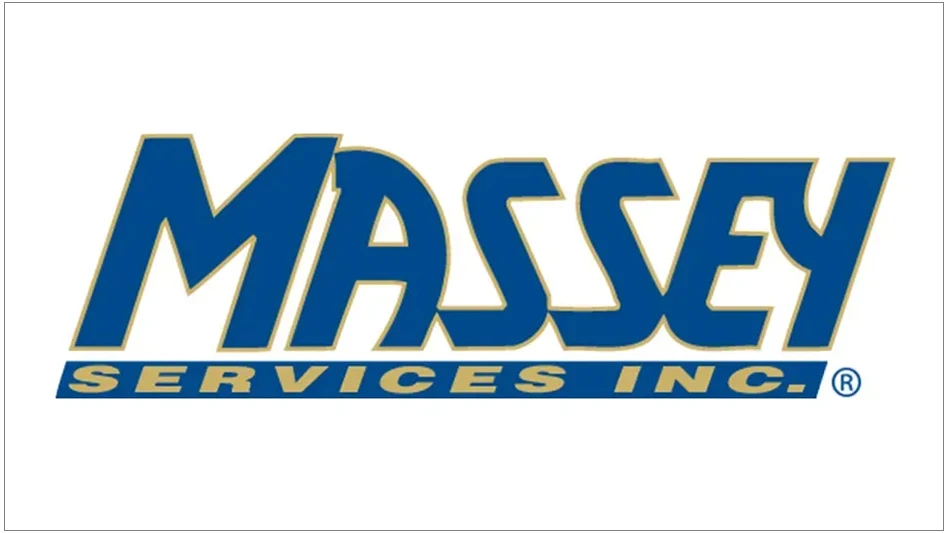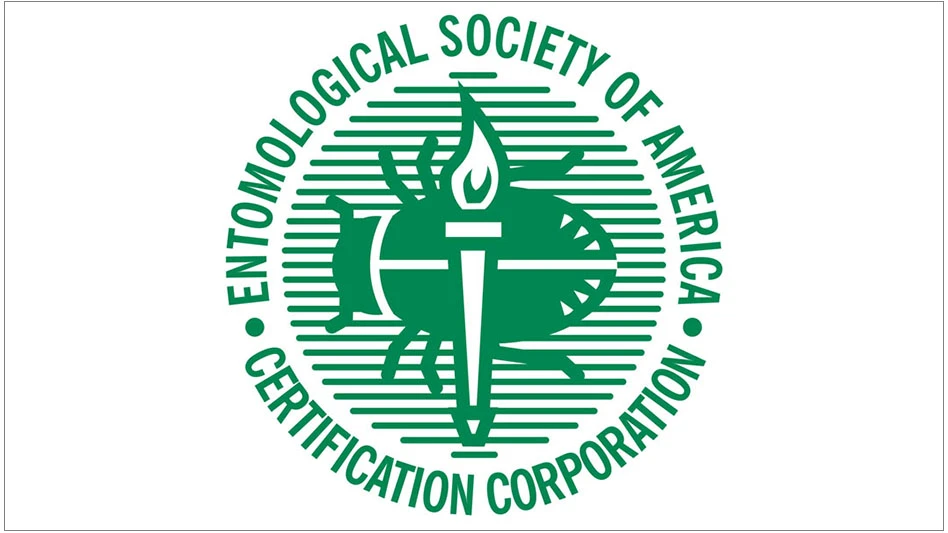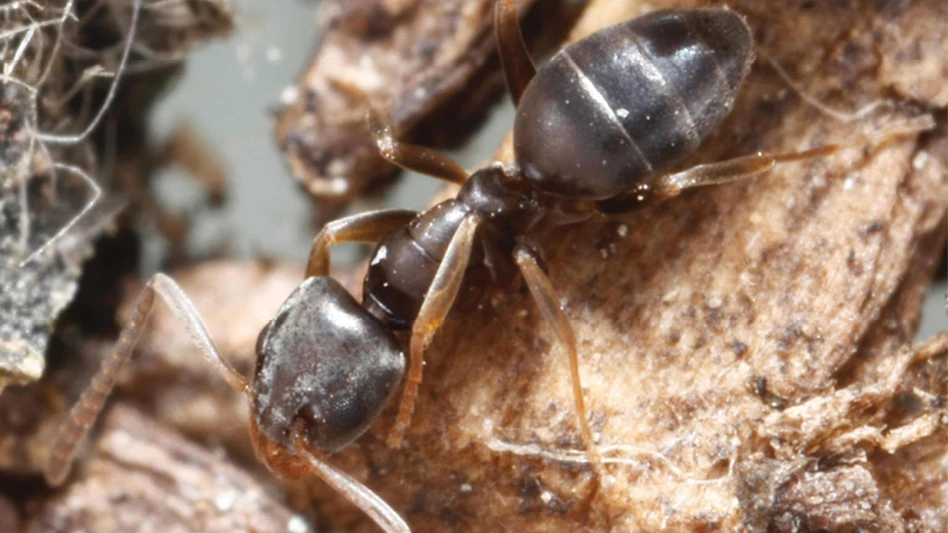
(Pictured: Bobby Corrigan (right) and Jody Gangloff-Kaufmann discussing exclusion of compactor room door.)
Where is the pest management industry heading: toward concentrating on eliminating pests once they become a problem in a home or building? Or, focusing on excluding potential pests before they become a problem? Jody Gangloff-Kaufmann, PhD, of the Geneva, N.Y.-based New York State IPM Program at Cornell University and leader of the working group The Scientific Coalition on Pest Exclusion (SCOPE),
presented an evaluation of exclusion in pest management, how pest control companies can begin adopting exclusion methods, and why the industry should be heading in the exclusion direction. The concept of SCOPE was pioneered by Dr. Bobby Corrigan, a founder and member of this working group.
Exclusion Explained
What exactly does pest exclusion mean? Gangloff-Kaufmann describes pest exclusion as making repairs and improvements to the exterior of buildings to prevent pest entry from outside; making repairs inside to prevent pest movement from one space to another; and, altering outdoor pest habitat to eliminate harborage near buildings. “We know the pests are outside, but how can we prevent them from getting in or keep them from going from apartment to apartment?” Gangloff-Kaufmann asks. Obviously, keeping pests out of homes and buildings is common sense, she acknowledges. But it is important to recognize that exclusion work can be challenging, especially in older and adjoining structures. Over time, for example, buildings deteriorate and people create openings in structures, like such as holes for cable or internet infrastructure.
The greatest reasons to practice exclusion in pest management are for health and safety factors, including human exposure to rodenticides, pest transmission of pathogens that cause diseases and illnesses, and pest-caused structural damage. Consider the fact that rodenticide sales are steady or increasing as of 2014, shares Gangloff-Kaufmann, but despite the use of rodenticide baits, mice and rats persist, especially in urban areas. Unfortunately, per the Centers for Disease Control and Prevention (CDC), over 11,000 cases of potentially hazardous exposures to rodenticides were reported in 2014. If rodents can get inside, they will get inside, and despite the use of rodenticides, and we’re not winning the battle, explains Gangloff-Kaufmann. Rodents can chew through wires and cause electrical shorts, they can undermine sidewalks, and rodent droppings are dangerous to human health, she explains.
A Reason for Exclusion: Health and Safety
- Rodents can cause serious damage to buildings (insulation, plumbing, electric, infrastructure), to sidewalks, and to reputations of businesses (food industry)
- Rodents can cause fires (chewing through wires and causing shorts)
- Rodents and cockroaches transmit pathogens and parasites, and trigger asthma
- Rodents can bite, injure, and even kill
Gangloff-Kaufmann explains that pest management professionals “are protectors of human property and health, and we are really obligated to do something about this.” As a result, exclusion is a good approach and solution. And, the concept is not new. Gangloff-Kauffman shares that in 1939, Dr. Hugo Hartnack, a veterinarian, researcher, and exterminator described that builders and architects need to consider “building out” pests by removing their food and shelter and creating “rat-proof buildings.”
Scoping out Exclusion
In an effort to study and help promote the use of exclusion methods in the pest control industry, a new venture was formed and called The Scientific Coalition on Pest Exclusion (SCOPE). This effort was led by Bobby Corrigan, PhD, industry expert and world-renowned rodentologist. Jody Gangloff-Kaufmann assembled a group of experts focused on addressing exclusion issues in residential settings, while Steven Kells, PhD, from the University of Minnesota created a working group for industrial and commercial pest exclusion. The group worked with stakeholders in the commercial, residential, food industry, scientific, and pest management professional areas to obtain input.
The SCOPE Concept
Effective pest management plans for residential, municipal, and commercial buildings should rely upon pest exclusion as a prerequisite for sustainable pest control and prevention.
The Challenge
Attaining industry-wide adoption of exclusion as the “number one” pest management technique.
Objectives
- Compile the science in pest exclusion and determine what is missing.
- Create tools that make exclusion inspections easier and intuitive.
- Explain the cost-benefit analysis of exclusion work.
- Create training materials (courses, lists, dictionaries, and videos) that improve skills and confidence.
Current State
As part of the study objectives, SCOPE also performed evaluations of the current use or non-use of exclusion in the pest management industry. Via an online Facebook group for pest management discussion, a survey was posted to obtain feedback on why pest control operators might not be using exclusion methods today. Thirty-five percent of respondents shared that their companies offer exclusion services and, that customers are not willing to pay for those services. “Customers have always devalued pest control, so we need to be better at selling these kinds of programs,” counters Gangloff-Kaufmann. Not all technicians have been trained or have the skills to perform exclusion, responded 32 percent of the survey respondents. And, fifteen percent stated that exclusion takes too much time on the job. “We need to increase technician skill level and change our formula to allow for exclusion. We know it can be very useful,” explains Gangloff-Kaufmann.
An additional fear in the pest management industry is that exclusion could potentially reduce call volume and revenue; if pests are excluded from homes and businesses, would customers continue to call pest control companies? To ease concerns, Gangloff-Kaufmann explains that the creation of cockroach and ant bait systems revolutionized the pest control industry, yet these products have not reduced the amount of work for PCOs. Plus, information to do-it-yourself for pest control solutions are widely available on the internet for homeowners. “This still hasn’t reduced the calls. We want to do a better job of pest control,” she says. “Pest management is still thriving.”
New Direction
The “new school” direction in Integrated Pest Management is the shift from reactive to proactive, and a concept promoted by Bobby Corrigan. A reactive approach is when customers call pest control companies because they need help or find evidence of an infestation. A proactive approach is more about a pest management professional evaluating customers’ homes and business to determine how to fix vulnerabilities before pests invade. Reactive measures will still be required and can be performed based on need. But, rather than just reacting, the pest management industry needs to understand how the building provides entry, habitat, and opportunity for pests, explains Gangloff-Kaufmann.
Exclusion Adoption
For a pest management business to adopt pest exclusion techniques, the shift in priority needs to be preventing rather than solving, explains Gangloff-Kaufmann. The pest control company needs to understand building construction and must teach technicians what to look for, such as types of openings that are important for pests, evidence of pest activity, and evaluation of potential pest harborage, such as hollow cement blocks. Technicians should always carry the right tools to make repairs. Gangloff-Kaufmann suggests sealants (rather than caulk, which does not last over time), concrete patch repair; brush or steel fiber fill door sweeps; stainless steel mesh hardware cloths and screens; copper or stainless steel fiber fillers; vent covers; and even building materials when necessary.
Temporary exclusion – with materials such as steel, copper wool, expanding foam, and caulk – is acceptable if the pest management professional plans to return to the site to follow up, Gangloff-Kaufmann explains. “Come back and do it the right way,” she says. The longer-term focus should be on materials that offer permanent exclusion, such as sealants, concrete, wood, building materials, hardware cloth, and screens.
A checklist or worksheet should be used during an initial visual inspection of a building to help track openings and broken items. Spotting pest evidence, such as feces, foot prints, tracks and rub marks is essential, and “the size of the opening matters,” states Gangloff-Kaufmann. Cockroaches, for instance, can fit into a 1.66mm opening, yellow jackets (3mm); mice (6mm flat, not round), bats (6mm), and rats (9.55mm), she explains.
In addition to exterior openings, pest management professionals need to consider interior exclusion. “Seal points of access to prevent movement of pests among rooms and floors in a building,” explains Gangloff-Kaufmann. She advises sealing cracks, crevices, baseboards, molding, and evaluating behind and under cabinets, and utility rooms. Eliminate harborage by filling in gaps and spaces where pests hide.
Landscaping, too, is a consideration, as vines and shrubs provide food, water, and harborage for ants, termites, cockroaches, mice, rats, chipmunks, squirrels, and yellowjackets. And, mulch encourages odorous house ants where they make colonies and invade structures. As a result, Gangloff-Kaufmann suggests cutting trees, shrubs, and plants twelve inches from the structure, and providing a pebble barrier around the foundation.
The Proof Is in the Pieces
Per a SCOPE and Pest Cemetery Exclusion Survey conducted between November 2016 and March 2017, participants were asked “What exclusion materials do techs typically carry to job sites? (Check all that apply)” The answers were as follows:
- Copper or steel wool: 21%
- Sealants / caulks: 20%
- Screen or hardware cloth: 19%
- Expanding foam: 15%
- Concrete patch: 13%
- Wood and other building materials: 8%
- Other: 4%
Per Gangloff-Kaufmann, the fact that only 21% are carrying copper or steel wool and 20% sealants and caulks is not encouraging. “Not enough attention is being paid to exclusion. Even simple sealants should be more available.” she says.
Latest from Pest Control Technology
- Tips to Maintain Backpack Sprayer's for Maximum Productivity
- Ecolab Reports Strong 2024 Financial Performance
- All U Need Pest Control Announces Entomology Certifications
- Eve Pappas on Continuing to Mentor the Next Generation of PMPs
- NPMA’s 2025 Women's Forum Registration Opens
- NCPMA Hosts 75th Pest Control Technician's School
- Pest Pros Pest Solutions Promotes Frank Cropper
- Pest Management Foundation Announces 2024-2025 Student Scholarship Recipients





